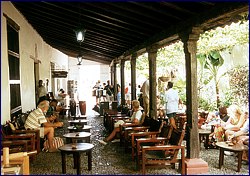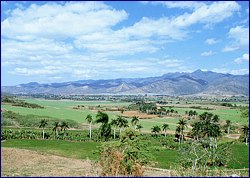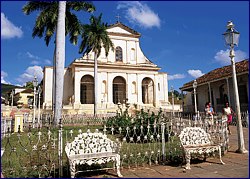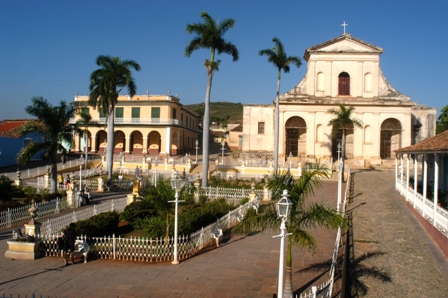 |
 |

Almost half a millennium of history has left its indelible stamp on Central Cuba’s two major centres, founded in 1514 by the Spanish conquistadors. Today, Sancti Spiritus is a flourishing town bustling with trade in sugar, tobacco and cattle. Trinidad is a city frozen in time—whose ancient palaces and colonial architecture remain unchanged.
A flourishing economy of sugar, tobacco and cattle raising keeps Sancti Spritus a busy central trade centre. Trinidad, on the other hand, has remained frozen in time. Founded by emigrants from the Canary Islands, the city has preserved its old palaces and colonial architecture, and become a key tourist attraction.
Trinidad is also blessed with magnificent Caribbean beaches and the Escambray, a rugged mountain range. The colonial town and adjacent Valle de los Ingenios, (Valley of the Sugar Mills) were declared a UNESCO World Heritage Site in 1983.
| Places to visit |

![]() Yayabo Bridge
Yayabo Bridge
Built in the early 19th century, this Roman-style bridge symbolizes the city of Sancti Spíritus and the province. The town’s 17th-century Iglesia Parroquial Mayor (Major Parish Church) is the oldest church in Cuba and a good example of Spanish-Arab influence.
![]() San José de Lago
San José de Lago
Thousands of families were founded here by emigrants from the Canary Islands; most of them later engaged in tobacco growing, keeping their traditions alive.
![]() Valle de los Ingenios
Valle de los Ingenios
East of Trinidad are the ruins of some 70 centuries-old sugar mills. The stunning, 146-foot-high Iznaga Tower, built around 1840, looms over the valley as a reminder of days when slaves worked the cane fields and the mills.
![]() Trinidad
Trinidad
This stunning 500-year-old town is a museum in itself. Cobblestone streets and palatial 18th- and 19th-century houses contribute to its unique colonial ambience.
![]() Milagroso Cristo de Vera Cruz
Milagroso Cristo de Vera Cruz
(Miraculous Christ of Vera Cruz). This bow ornament, from a Spanish galleon that landed here in the early 18th century, remains in Trinidad's parish church.
![]() Ermita de la Popa
Ermita de la Popa 
(the Popa Hermitage). Inspired by Spanish maritime tradition, this church was built centuries ago on the road up to La Vigía in Trinidad so that it could be seen from the sea.
![]() Topes de Collantes
Topes de Collantes
In the mountains some 20 kilometres from Trinidad, is one of Cuba’s main ecotourism centres.
![]() Beaches
Beaches
Most beaches in the area are on Casilda Bay, where the clear water also offers excellent snorkeling and diving. A nearby islet has pristine, powdered-sand beaches.
 28.24°C
28.24°C




